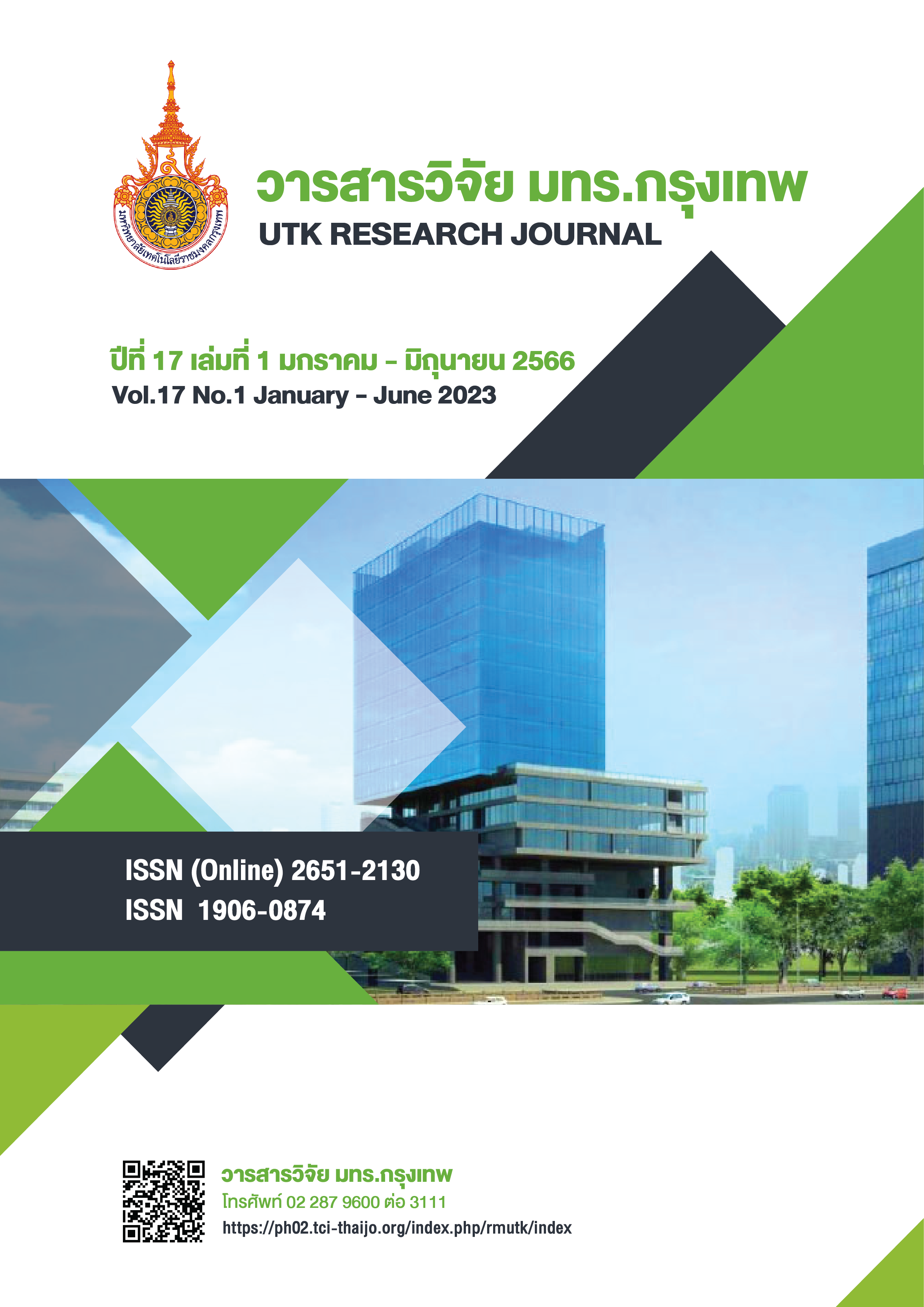การศึกษาประสิทธิภาพการเจาะรูด้วยกระบวนการกัดเซาะด้วยไฟฟ้าของรอยเชื่อม เหล็กกล้าเครื่องมือ เกรด AISI P20
บทความวิจัย
คำสำคัญ:
เหล็กกล้าเครื่องมือ เกรด AISI P20, อัตราการขจัดเนื้องาน, อัตราการสึกหรอของอิเล็กโทรด, ความหยาบผิวบทคัดย่อ
งานวิจัยนี้มีวัตถุประสงค์เพื่อศึกษาปัจจัยที่เหมาะสมในการเจาะรูด้วยกระบวนการกัดเซาะด้วยไฟฟ้า (EDM) สำหรับวัสดุเหล็กกล้าเครื่องมือ เกรด AISI P20 ที่ผ่านการเชื่อมซ่อมด้วยการเชื่อมไฟฟ้า (SMAW) และการเชื่อมอาร์กโลหะด้วยแก๊ส (GMAW) ด้วยการใช้อิเล็กโทรดทองเหลืองและทองแดง ภายใต้การปรับค่ากระแสไฟฟ้า 3 ระดับ ได้แก่ 2.5, 3 และ 3.5 แอมแปร์ จากนั้นประเมินผลประสิทธิภาพการทำงานในรูปของอัตราการขจัดเนื้องาน (MRR) อัตราการสึกหรอของอิเล็กโทรด (EWR) ความหยาบผิว (Ra) และลักษณะรูเจาะเข้า-ออก ตามลำดับ ผลการทดลองพบว่ารูเจาะของรอยเชื่อม SMAW ที่ถูกสปาร์คด้วยอิเล็กโทรดทองเหลืองมีอัตราการขจัดเนื้องานสูงสุด 22.439 มม.2/นาที และอัตราการสึกหรอของอิเล็กโทรด 98% ที่ใช้กระแสไฟฟ้า 3 แอมแปร์ สำหรับรอยเชื่อม GMAW ที่ถูกสปาร์คด้วยอิเล็กโทรดทองแดงมีความหยาบผิวเฉลี่ยต่ำสุดเท่ากับ 4.0198 ไมโครมิเตอร์ ที่ใช้กระแสไฟฟ้า 3.5 แอมแปร์ ลักษณะรูเจาะของทั้งสองรอยเชื่อม SMAW และ GMAW จากการใช้อิเล็กโทรดทั้งสองประเภทและทั้งหมดของการปรับค่ากระแสไฟฟ้ามีขนาดเส้นผ่านศูนย์กลางรูเข้ามากกว่า 1 มม. และมีขนาดเส้นผ่านศูนย์กลางรูออกน้อยกว่า 1 มม.
References
Boonloerd TH, Sawai D. High temperature tensile properties of hot-pressed inconel 718. Department of metallurgical engineering. Faculty of engineer. Chulalongkorn university. 1999.
Yusuf K, H. Selçuk H, Mevlüt K. An experimental study for determination of the effects of machining parameters on surfaces roughness in electrical discharge machining (EDM). Springer–Verlag London Limited (Electronic). 2006(28):1118-21.
Thomas B. Technology of electrical discharge machining. Druckerei Helene 6102. 1991:11-53.
Bissacco G, Valentincic J, Hansen H.N., et al. Towards the effective tool wear control micro-EDM milling. Int J Adv Manuf Tecnol. 2010; 47:3-9.
Ngangkham D, Shrikrishna N.J. Electric discharge alloying of titanium and aluminium on AISI P20 mold steel. Surface & Coatings Technology. 2020;405:(125157):126515
Viswanathan G, Praveen R, Prabhu L, et al. Evaluating the machining parameters for milling P20 HH mould steel using a specific end mill. Materials Today: Proceedings 46(17). 2021;8248-8253.
Li-Ho Ch, Chang-Hui W, Heng Ch. Wear behavior of nitrocarburized JIS SKD61 tool steel. Wear 253. 2002:778-86.
Sir-Alexci S, Albert M.S, Wilson T.P. et al. Arc Welding Procedures on Steels for Molds and Dies. Procedia engineering 100. 2015:584-91.
กมลพงค์ แจ่มกมล, พิชัย จันทร์มณี. การศึกษาพารามิเตอร์ในการกัดเซาะวัสดุด้วยไฟฟ้าสำหรับเหล็กกล้าแม่พิมพ์ AISI P20. KKU Engineering journal. 2013;40(1):95-103.
พิชัย จันทร์มณี, อภิวัฒน์ มุตตาระ. การศึกษาปัจจัยที่มีผลต่อการอีดีเอ็มทังสเตนคาร์ไบด์ด้วยทากูชิเทคนิค. การประชุมวิชาการทางวิศวกรรมศาสตร์ มหาวิทยาลัยสงขลานครินทร์ ครั้งที่ 8. วันที่ 22-23 เมษายน 2553.
Kamonpong J, Pichai J. Improving machining performance for deep hole drilling in the electrical discharge machining process using a step cylindrical electrode. Appl. Sci. 2021;11(5):2084.
Hardeep S, Jujhar S, Shubham SH, et al. Parametric optimization of MRR & TWR of the Al6061/SiC MMCs processed during die-sinking EDM using different electrodes. Materials Today: Proceedings 48(5). 2021;1001-1008.
Tahsin T.O. Manufacturing of micro holes by using micro electric discharge machining. A Thesis submitted to the graduate school of natural and applied sciences of atilim university. In partial fulfillment of the requirements for the degree of master of science in the department of mechatronics engineering. 2008.
Ngangkham D, Shrikrishna N.J. Surface alloying of Ti-6Al-4V on P20 mold steel using electric discharge processing (EDP). Materials Today: Proceedings 5(2). 2018;8523–8531.
Downloads
เผยแพร่แล้ว
ฉบับ
บท
License
Copyright (c) 2023 วารสารวิจัย มทร. กรุงเทพ

This work is licensed under a Creative Commons Attribution-NonCommercial-NoDerivatives 4.0 International License.
กองบรรณาธิการวารสารวิชาการ มหาวิทยาลัยเทคโนโลยีราชมงคลกรุงเทพ มีความยินดีที่จะรับบทความจากอาจารย์ นักวิจัย นักวิชาการทั้งภายในและภายนอกมหาวิทยาลัย ในสาขาวิชาวิทยาศาสตร์และเทคโนโลยี ได้แก่ สาขาวิชาวิทยาศาสตร์ วิศวกรรมศาสตร์ และสาขาอื่นๆ ที่เกี่ยวข้อง รวมถึงสาขาต่างๆ ที่มีการบูรณาการข้ามศาสตร์ที่เกี่ยวข้องวิทยาศาสตร์และเทคโนโลยี ที่เขียนเป็นภาษาไทยหรือภาษาอังกฤษ ซึ่งผลงานวิชาการที่ส่งมาขอตีพิมพ์ต้องไม่เคยเผยแพร่ในสิ่งพิมพ์อื่นใดมาก่อน และต้องไม่อยู่ในระหว่างการพิจารณาของวารสารอื่น
การละเมิดลิขสิทธิ์ถือเป็นความรับผิดชอบของผู้ส่งบทความโดยตรง บทความที่ได้รับการตีพิมพ์ต้องผ่านการพิจารณากลั่นกรองคุณภาพจากผู้ทรงคุณวุฒิและได้รับความเห็นชอบจากกองบรรณาธิการ
ข้อความที่ปรากฏอยู่ในแต่ละบทความที่ตีพิมพ์ในวารสารวิชาการเล่มนี้ เป็นความคิดเห็นส่วนตัวของผู้เขียนแต่ละท่าน ไม่เกี่ยวข้องกับมหาวิทยาลัยเทคโนโลยีราชมงคลกรุงเทพแต่อย่างใด ความรับผิดชอบด้านเนื้อหาและการตรวจร่างบทความแต่ละบทความเป็นของผู้เขียนแต่ละท่าน หากมีความผิดพลาดใดๆ ผู้เขียนแต่ละท่านจะต้องรับผิดชอบบทความของตนเองแต่ผู้เดียว
กองบรรณาธิการขอสงวนสิทธิ์มิให้นำเนื้อหา หรือข้อคิดเห็นใดๆ ของบทความในวารสารวิชาการ มหาวิทยาลัยเทคโนโลยีราชมงคลกรุงเทพ ไปเผยแพร่ก่อนได้รับอนุญาตจากกองบรรณาธิการ อย่างเป็นลายลักษณ์อักษร ผลงานที่ได้รับการตีพิมพ์ถือเป็นลิขสิทธิ์ของวารสาร





